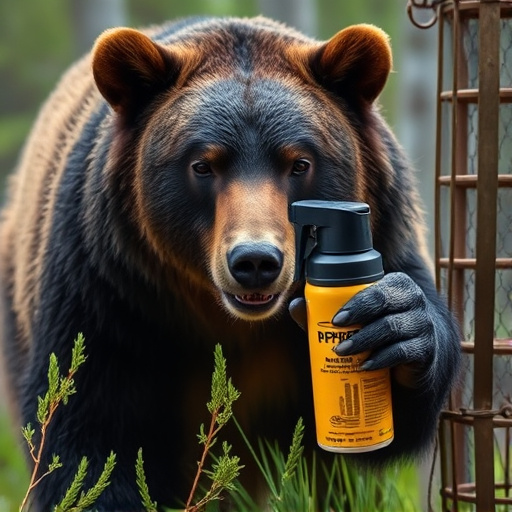Understanding what chemicals are in bear spray is crucial for effective self-defense against wildlife. Capsaicin from chili peppers, combined with other compounds like piperidine and alkane esters, creates a potent barrier that disorients bears. Modern formulations include PCCA and fluorocarbons for enhanced reach and persistence. Selecting the right bear spray involves examining active ingredients like capsaicin or 4-alkyl amphotere (4AA) to tailor defense to specific encounters with grizzlies or black bears.
In the vast wilderness, encountering a bear can be an intimidating experience. Bear spray, a crucial defense mechanism, offers individuals a sense of security during outdoor adventures. This article delves into the chemistry behind these powerful tools, exploring what chemicals are in bear spray and how they work. From understanding key ingredients to assessing safety, we break down the science, helping you make informed choices when selecting bear spray for your next outdoor endeavor.
- Understanding Bear Spray Chemistry
- Key Ingredients for Effectiveness
- Chemical Composition and Safety
- How Chemicals Interact with Bears
- Choosing Spray Based on Active Ingredients
Understanding Bear Spray Chemistry
Bear spray, a powerful defense mechanism against potential wildlife encounters, is more than just a typical aerosol. Its effectiveness lies in its unique chemical composition designed to deter bears. When deployed during an encounter, the spray creates a barrier of capsaicin-based agents that irritate a bear’s eyes and nasal passage, temporarily disorienting it.
The key chemical ingredient in most bear sprays is capsicum, derived from chili peppers. This compound, responsible for the stinging sensation in bear spray, is usually coupled with other chemicals like chloroacetamide or oleoresin capsaicin. These additives enhance the spray’s persistence and potency, ensuring a longer-lasting effect to create space during an unexpected wildlife interaction.
Key Ingredients for Effectiveness
When it comes to effectiveness, bear spray defense is only as good as its key ingredients. A quality product should primarily contain capsaicin, a compound derived from chili peppers that stimulates nerve endings, causing bears to recoil and temporarily incapacitate them. This natural chemical agent is often combined with other powerful substances like piperidine and various alkane esters to enhance its potency.
Understanding what chemicals are in bear spray is crucial for assessing its performance. These ingredients not only ensure a strong reaction from the spray but also play a vital role in its range, accuracy, and overall effectiveness during a potentially life-threatening encounter with wild bears.
Chemical Composition and Safety
Bear defense spray, a crucial tool for outdoor enthusiasts navigating wild landscapes, is more than just a deterrent; it’s a complex chemical composition designed to protect. The active ingredient, often listed as capsaicin, is derived from chili peppers and is known for its effectiveness in irritating a bear’s eyes and nose, creating a safe escape route. However, what sets these sprays apart is the blend of chemicals that ensure both potency and safety.
Beyond capsaicin, modern bear spray formulations include additional agents like piperidine carboxylic acid (PCCA) and various fluorocarbons. These chemicals enhance the spray’s reach, persistence, and overall effectiveness against bears. Safety is paramount; these sprays are designed to minimize harm to humans while deterring aggressive behavior in bears. Proper usage involves understanding the spray’s range, wind conditions, and the unique chemistry that makes it a game-changer in bear encounter scenarios.
How Chemicals Interact with Bears
Bear encounter defense spray, also known as bear spray, is a crucial tool for outdoor enthusiasts navigating wild environments. Its effectiveness hinges on the interaction between powerful chemicals and bears’ sensitive senses. These sprays typically contain capsaicin, the same chemical that makes chili peppers spicy. When activated, the spray releases a fine mist containing this irritant into the air, reaching the bear’s eyes, nose, and mouth.
The capsaicin disrupts the bear’s sensory perception, temporarily blinding it and irritating its respiratory system. This disruption can cause the bear to retreat, providing the user with vital time to escape or stand their ground, depending on the situation. Understanding what chemicals are in bear spray is essential for knowing how it works and choosing the right defense for your specific wilderness adventures.
Choosing Spray Based on Active Ingredients
When considering bear spray for defense, it’s crucial to look beyond brand and price tags and focus on what chemicals are actually contained within. Different bear sprays use various active ingredients designed to deter an attack by temporarily incapacitating or irritating bears. Common chemical components include capsaicin, a compound found in chili peppers that causes pain and tears, and various types of pepper spray derived from hot peppers.
Some bear sprays also incorporate other chemicals like 4-alkyl amphotere (4AA) which creates a foam barrier upon impact, blocking the bear’s nasal passages and eyes. Understanding what chemicals are in bear spray allows you to choose the most effective option based on your specific needs and potential encounters—whether it’s grizzly bears known for their strength and aggression or black bears more prone to curiosity than hostility.
Bear spray, a vital defense tool during wilderness encounters, relies on specific chemical compositions to deter and repel bears. Understanding the chemistry behind these sprays is crucial for choosing an effective product. Key ingredients, such as capsaicin and pepper-based compounds, create a safe yet potent solution. By knowing what chemicals are in bear spray, users can make informed decisions, ensuring they’re prepared for any potential wildlife interaction.
